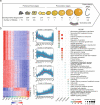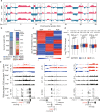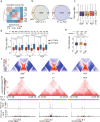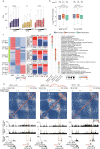Dynamic transcriptome and chromatin architecture in granulosa cells during chicken folliculogenesis
- PMID: 35013308
- PMCID: PMC8748434
- DOI: 10.1038/s41467-021-27800-9
Dynamic transcriptome and chromatin architecture in granulosa cells during chicken folliculogenesis
Abstract
Folliculogenesis is a complex biological process involving a central oocyte and its surrounding somatic cells. Three-dimensional chromatin architecture is an important transcription regulator; however, little is known about its dynamics and role in transcriptional regulation of granulosa cells during chicken folliculogenesis. We investigate the transcriptomic dynamics of chicken granulosa cells over ten follicular stages and assess the chromatin architecture dynamics and how it influences gene expression in granulosa cells at three key stages: the prehierarchical small white follicles, the first largest preovulatory follicles, and the postovulatory follicles. Our results demonstrate the consistency between the global reprogramming of chromatin architecture and the transcriptomic divergence during folliculogenesis, providing ample evidence for compartmentalization rearrangement, variable organization of topologically associating domains, and rewiring of the long-range interaction between promoter and enhancers. These results provide key insights into avian reproductive biology and provide a foundational dataset for the future in-depth functional characterization of granulosa cells.
© 2022. The Author(s).
Conflict of interest statement
The authors declare no competing interests.
Figures






Similar articles
-
Transcriptome Dynamics and Cell Dialogs Between Oocytes and Granulosa Cells in Mouse Follicle Development.Genomics Proteomics Bioinformatics. 2024 Jul 2;22(2):qzad001. doi: 10.1093/gpbjnl/qzad001. Genomics Proteomics Bioinformatics. 2024. PMID: 38955498 Free PMC article.
-
Transcriptome profiling of sheep granulosa cells and oocytes during early follicular development obtained by laser capture microdissection.BMC Genomics. 2011 Aug 18;12:417. doi: 10.1186/1471-2164-12-417. BMC Genomics. 2011. PMID: 21851638 Free PMC article.
-
The dormant and the fully competent oocyte: comparing the transcriptome of human oocytes from primordial follicles and in metaphase II.Mol Hum Reprod. 2013 Sep;19(9):600-17. doi: 10.1093/molehr/gat027. Epub 2013 Apr 18. Mol Hum Reprod. 2013. PMID: 23598597
-
Meta-analysis of gene expression profiles in granulosa cells during folliculogenesis.Reproduction. 2016 Jun;151(6):R103-10. doi: 10.1530/REP-15-0594. Epub 2016 Mar 15. Reproduction. 2016. PMID: 26980808 Review.
-
The transcriptome of follicular cells: biological insights and clinical implications for the treatment of infertility.Hum Reprod Update. 2014 Jan-Feb;20(1):1-11. doi: 10.1093/humupd/dmt044. Epub 2013 Sep 29. Hum Reprod Update. 2014. PMID: 24082041 Free PMC article. Review.
Cited by
-
Pterostilbene, a Resveratrol Derivative, Improves Ovary Function by Upregulating Antioxidant Defenses in the Aging Chickens via Increased SIRT1/Nrf2 Expression.Antioxidants (Basel). 2024 Aug 1;13(8):935. doi: 10.3390/antiox13080935. Antioxidants (Basel). 2024. PMID: 39199181 Free PMC article.
-
Hi-C analysis of genomic contacts revealed karyotype abnormalities in chicken HD3 cell line.BMC Genomics. 2023 Feb 7;24(1):66. doi: 10.1186/s12864-023-09158-y. BMC Genomics. 2023. PMID: 36750787 Free PMC article.
-
Function and Evolution of the Loop Extrusion Machinery in Animals.Int J Mol Sci. 2023 Mar 6;24(5):5017. doi: 10.3390/ijms24055017. Int J Mol Sci. 2023. PMID: 36902449 Free PMC article. Review.
-
Porcine Granulosa-Cell-Derived Exosomes Enhance Oocyte Development: An In Vitro Study.Antioxidants (Basel). 2024 Mar 14;13(3):348. doi: 10.3390/antiox13030348. Antioxidants (Basel). 2024. PMID: 38539881 Free PMC article.
-
Integrated metabolome and transcriptome analysis reveals key genes and pathways associated with egg yolk percentage in chicken.Poult Sci. 2025 Mar;104(3):104815. doi: 10.1016/j.psj.2025.104815. Epub 2025 Jan 17. Poult Sci. 2025. PMID: 39914020 Free PMC article.
References
-
- Li R, Albertini DF. The road to maturation: somatic cell interaction and self-organization of the mammalian oocyte. Nat. Rev. Mol. Cell Biol. 2013;14:141–152. - PubMed
-
- Albertini DF. Regulation of meiotic maturation in the mammalian oocyte: Inteplay between exogenous cues and the microtubule cytoskeleton. Bioessays. 1992;14:97–103. - PubMed
-
- Gilchrist RB, Ritter LJ, Armstrong DT. Oocyte–somatic cell interactions during follicle development in mammals. Anim. Reprod. Sci. 2004;82:431–446. - PubMed
-
- Zhu G, et al. Differential expression of CTGF in pre- and post-ovulatory granulosa cells in the hen ovary is regulated by TGFβ1 and gonadotrophins. Gen. Comp. Endocrinol. 2012;178:314–322. - PubMed
Publication types
MeSH terms
Substances
LinkOut - more resources
Full Text Sources
Molecular Biology Databases

